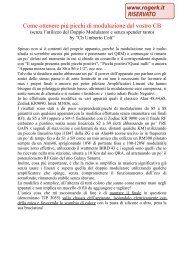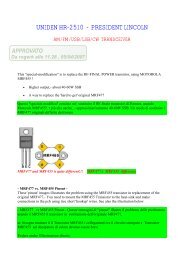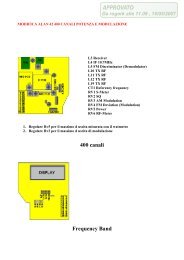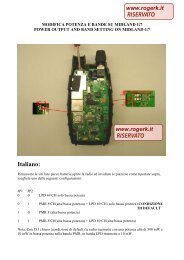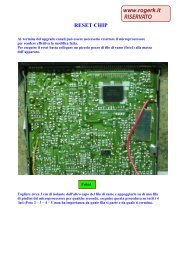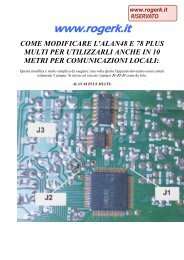Modifications for the ICOM - RogerK
Modifications for the ICOM - RogerK
Modifications for the ICOM - RogerK
- No tags were found...
Create successful ePaper yourself
Turn your PDF publications into a flip-book with our unique Google optimized e-Paper software.
19-07-1998(IC-W2A) IC-W2A signal levelHere is more info on <strong>the</strong> <strong>the</strong> per<strong>for</strong>mance of <strong>the</strong> W2A after <strong>the</strong> mod.Well folks I have had my IC-W2A <strong>for</strong> one week now & am,needless to say suitably impressed. But now my comments...Why did Icom have to change <strong>the</strong> DC input socket to what <strong>the</strong> W2A has. It is very unusual & as far as I can find out, Icom are<strong>the</strong> only people who can supply a plug <strong>for</strong> it. I think <strong>the</strong>y should have stayed with <strong>the</strong> more common 2.1mm DC jack as per <strong>the</strong>IC-32AT.I did some checks of <strong>the</strong> receivers using an IFR 500A signal generator & <strong>the</strong> following is what signal level I needed to get 1 "S"point on <strong>the</strong> W2A's S meters.70MHz, 1mV (milli-volts) 80MHz 0.5mV 90MHz 0.25mV 100MHz 75µV (micro-volts) 110MHz 1.5µV From here to 170MHz lessthan 0.2µV 173MHz 1.5µV 174MHz 75µV 200MHz 75µV 250MHz 0.5mV (whats going on here???) 275MHz 4µV 300MHz 1.5µV320MHz 5µV (changed to UHF main VFO from here on) 400 - 450MHz less than 0.35µV 460MHz 0.75µV 465 - 510MHz less than1µV 520 - 690MHz less than 2µV 700 - 999MHz varies from 7.5µV to 2µV, dips to 0.35µV at 900MHz. Quite impressive, but Iwould really like to get better sensitivity at <strong>the</strong> 70 - 80mhz end. Studying <strong>the</strong> circuit diagram shows bandpass/bandstop filters allover <strong>the</strong> show, so maybe its possible to modify a few to increase sensitivity here.I am ga<strong>the</strong>ring toge<strong>the</strong>r <strong>the</strong> ciruits of <strong>the</strong> Icom IC-R1, IC-24AT & W2A to compare <strong>the</strong> front ends so we will see what comes ofthis experiment in <strong>the</strong> near future.One o<strong>the</strong>r worry was <strong>the</strong> on/off switch, how do you turn <strong>the</strong> set off when <strong>the</strong> battery is flat. I am concerned about running <strong>the</strong>battery to zero volts, hopefully this does not occur. I have been disconnecting <strong>the</strong> battery when charging to prevent anythingfunny happening.The antenna supplied with my W2A is an FA-1443BB, whats <strong>the</strong> difference between this & <strong>the</strong> FA-1443B, & <strong>the</strong> FA-4B suppliedwith an IC-R1.One more gripe, I dont like <strong>the</strong> plastic plug/covers over <strong>the</strong> DC jack, headphone, external speaker sockets, <strong>the</strong>y should havebeen rubber as per <strong>the</strong> IC-32AT, as I can see already that <strong>the</strong>y will not last very long after prolonged use. Boy what a moaner,you say, small complaints but this would really have made it <strong>the</strong> best. I wonder what Yaesu & Kenwood are going to do tocompete with this?This modification is read 959 times.top of page19-07-1998(IC-W2A) IC-W2A Weak transmit audioTrouble: Weak transmit audio, deviation below <strong>the</strong> specifications, high end of <strong>the</strong> speech spectrum missing.Tools needed: A good soldering iron with a sharp tip, desoldering braid, solder, sharp-nosed pliers, small cross-pointscrewdrivers.Cure:1. Open <strong>the</strong> radio case following <strong>the</strong> instructions in <strong>the</strong> owner's manual (p. 45).2. In radios fitted with <strong>the</strong> UT-63 board, pull out <strong>the</strong> board.3. Unscrew <strong>the</strong> two small screws holding <strong>the</strong> tin plate against <strong>the</strong> bottom ends of <strong>the</strong> band modules. Pull out <strong>the</strong> plate.4. Pull out <strong>the</strong> band modules.5. Now you see <strong>the</strong> microfone fitted to <strong>the</strong> mo<strong>the</strong>r board. It should fit neatly against <strong>the</strong> inside of <strong>the</strong> fascia panel. If itdoesn't, carry on.6. Unsolder <strong>the</strong> microphone leads from <strong>the</strong> mo<strong>the</strong>r board. BE CAREFUL not to overheat <strong>the</strong> board and <strong>the</strong> wire insulation.7. Pull out <strong>the</strong> microphone and <strong>the</strong> rubber gasket.8. Re-install <strong>the</strong> gasket. Pull in <strong>the</strong> microphone so that it fits inside <strong>the</strong> gasket well and press it firmly to <strong>the</strong> end.9. Re-solder <strong>the</strong> mic wires. Install <strong>the</strong> band modules, <strong>the</strong> tin plate and don't <strong>for</strong>get <strong>the</strong> screws.10. Replace <strong>the</strong> rear panel.11. Tighten <strong>the</strong> 7 screws.12. Test <strong>the</strong> audio response.This modification is read 891 times.top of page




